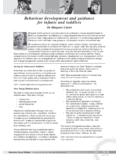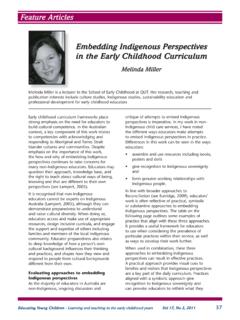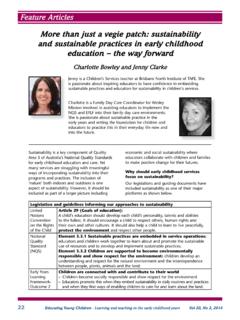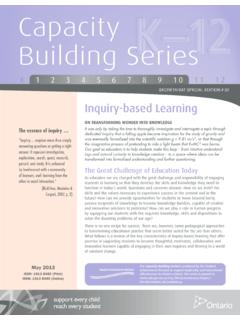Transcription of Motivation of Boys - ECTA
1 Motivation & Engagement of Boys Evidence-based Teaching Practices A Report submitted to the Australian Government Department of Education, Science and Training MAIN REPORT. Motivation and engagement of boys: Evidence-based teaching practices A report submitted to the Australian Government Department of Education, Science and Training (Main report). Dr Geoff Munns Dr Leonie Arthur Professor Toni Downes Dr Robyn Gregson Dr Anne Power Associate Professor Wayne Sawyer Professor Michael Singh Dr Judith Thistleton-Martin Frances Steele Dr Geoff Munns, UWS.
2 Dr Leonie Arthur, UWS. Professor Toni Downes (Project Leader). Dr Robyn Gregson, UWS. Dr Anne Power, UWS. Associate Professor Wayne Sawyer, UWS. Professor Michael Singh, UWS. Dr Judith Thistleton-Martin, UWS. Frances Steele (Project Manager), UWS. With the support of: Janet Fellowes, ECU. Margot Ford, CDU. Dr Susanne Gannon, UWS. Shirley Gilbert, UWS. Dr Bobby Harreveld, CQU. Dr Chris Hickey, DeakinU. Bronwyn Hubbard, UWS. Justine Lawson, UWS. Dr Andrew Martin, UWS. Dr Shalmalee Palekar, UWS. Dr Helen Woodward, UWS.
3 The views expressed herein do not necessarily represent the views of the Australian Government Department of Education, Science and Training. The project was funded by the Australian Government Department of Education, Science and Training as a quality teacher initiative under the Australian Government Quality Teacher Programme. The UWS Research team wishes to acknowledge and thank the state and territory education systems, the school principals, their staff, students and communities. Without their support it would not have been possible to undertake the research and reporting of current work in the selected schools.
4 In particular the research team was impressed by the dedication, hard work and critical insights into young people's lives that underpin the successful programmes documented in this report. 2. TABLE OF CONTENTS. GLOSSARY, ACRONYMS AND 5. EXECUTIVE SUMMARY .. 7. 1 21. 2 PROJECT OBJECTIVES AND OUTCOMES .. 22. 3 METHODOLOGY .. 24. THE MEE FRAMEWORK .. 25. Motivation (M) an individual 25. e'ngagement (e) a relational 27. E'ngagement (E) school is for me' .. 28. The MeE framework in action .. 29. REVIEW OF RESEARCH LITERATURE.
5 30. Conceptual framework for understanding Motivation and engagement .. 30. Synthesis of issues and factors impacting boys' education and social outcomes .. 30. Evidence-based strategies for improvement .. 30. CASE STUDIES .. 33. Characteristics of the case study schools .. 34. Processes for identifying potential case study schools .. 35. From potential schools to selected 36. Data Data 40. Validity .. 41. 4 LITERATURE 42. 42. Motivation AND ENGAGEMENT .. 42. Defining Motivation and 42. Motivation and engagement: Student outcomes and school factors.
6 43. BOYS' EDUCATION .. 44. Issues and 44. Boys' academic and social outcomes .. 44. STRATEGIES FOR IMPROVING THE Motivation , ENGAGEMENT, ACADEMIC SUCCESS AND. SOCIAL OUTCOMES OF BOYS .. 45. Home, community and school connections .. 46. Whole-school 46. Classroom-based 47. Language and literacy 48. CONCLUSION .. 48. 5 CASE 50. 50. THE CASE STUDIES .. 51. Motivation AND ENGAGEMENT IN THE CASE STUDY SCHOOLS .. 54. CONCLUSION .. 60. 6 PRINCIPLES AND STRATEGIES .. 61. THE PRINCIPLES .. 62. Overarching Principle: Use the MeE framework to guide the development of a whole- school approach.
7 63. Principle 2: Focus on student 63. Principle 3: Select a contextually relevant starting 65. Principle 4: Generate pathways that build a coherent and multifaceted 67. Principle 5: Develop professional leadership and professional learning .. 69. THE STRATEGIES .. 70. Motivation (M) individual support 72. 3. e'ngagement engaging messages about knowledge, ability, control, place and voice76. E'ngagement widely catering for each student at involvement, emotional and cognitive levels .. 80. CONCLUSION.
8 84. 7 CONCLUSION .. 87. INTERACTIONS, CONNECTIONS AND COMPLEXITIES .. 87. THE MEE FRAMEWORK .. 89. REWORKING SCHOOLING: INTEGRATING EXTRA-CURRICULAR ACTIVITIES INTO CURRICULUM. POLICY DEVELOPMENT .. 90. ENHANCEMENT OF THE TEACHING PROFESSION .. 92. CONCLUSIONS AND BEGINNINGS .. 94. REFERENCES .. 96. 4. GLOSSARY, ACRONYMS AND ABBREVIATIONS. ACER Australian Council of Educational Research ACTAP ACT Assessment Programme AET Aboriginal Education Teacher AEW Aboriginal Education Worker AGQTP Australian Government Quality Teaching Programme AIEO Aboriginal and Islander Education Officer AIEW Aboriginal and Islander Education Worker AFL Australian Rules Football AQF Australian Qualifications Framework ARC Australian Research Council ASSPA Aboriginal Student Support and Parent Awareness Programme BELS The Boys Education Lighthouse Schools
9 Project (BELS) is a Australian Government-funded national project aimed at promoting improved outcomes for boys. BELS 1 funded schools to document and showcase successful practices in the education of boys. BELS 2 funds clusters of schools to implement and evaluate innovative approaches to boys'. education. BST Basic Skills Test DECS Department of Education and Children's Services DEST Department of Education, Science and Training DET Department of Education and Training ELLA English Language and Literacy Assessment EMA Education Maintenance Allowance ENI Economic Needs Index ESL English as a Second Language FLC Flexible Learning Centre ICT Information and Communication Technology IEO Indigenous Education Officer IEPs Individual Education Programmes IETSO Indigenous Education and Training Support Officer KLAs Key Learning Areas MAP Multilevel Assessment Programme MOU Moving On and Up NESB Non-English
10 Speaking Background PA Books Personal Achievement Books RTO Registered Training Organisation SACE South Australian Certificate of Education (Stage 1: Yr 11, Stage 2: Yrs 12 and 13). SABSA Senior Assessment Board of South Australia SACSA South Australian Curriculum Standards and Accountability framework SAE Standard Australian English SAR School Annual Report SES Socioeconomic Status SLA Statistical Local Area SNEP Senior Negotiated Education Plan 5. SOSE Studies of Society and Environment TAFE Technical and Further Education TORC-3 Test of Reading Comprehension VCAL Vocational Learning VET Vocational Education and Training WALNA West Australian Literacy and Numeracy Assessment 6.











